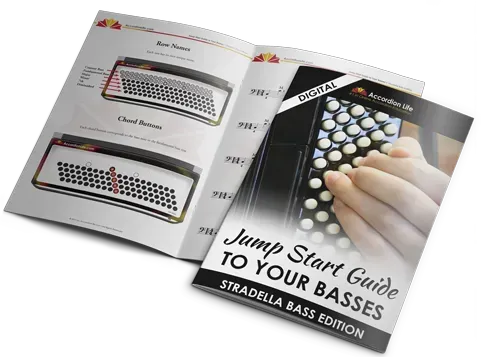
The Bass Debate: Which fingers do I use for the accordion bass buttons? 3-2 or 4-3?
The debate over which fingers to use for the bass side of the accordion is not a new one, but it can be quite a serious topic of discussion! At Accordion Life Academy, we teach using the 4-3 method for the accordion bass buttons. Let's talk about why.
Part of this discussion is taken from our YouTube video 7 Bass Patterns to Play on your accordion! Click HERE to watch it or scroll to the bottom of this article.
The Pros and Cons of the 3-2 Method for the Accordion Bass Buttons
There are two schools of thought for which fingers you should use on the bass buttons of the accordion.
There are pros and cons to both.
We teach the 4-3 method, and I’ll explain in a second why I recommend it, but there is another way that some people play the basses and that is with the 3-2 method. This method places finger three on the bass and finger two on the chord.
If you look at the anatomy of your fingers, the third finger is longer than the second finger. At first glance, it seems like the most logical fingering to use since on the accordion the bass note button rows are farther forward than the chord buttons.
I find most self-taught accordion players use this fingering because it’s the easiest as a beginner and the layout seems logical. The second reason to use this would be in advanced music when you need to use the fifth finger to reach distances—you have a wider spread between fingers 3 and 5 than you do between fingers 4 and 5.
Now the cons to the 3-2 method are that when you get outside of the very basic rhythm patterns for the bass you run into trouble because the 3rd finger has to do double duty playing the accordion bass buttons and what we call the alternate bass buttons. This causes constant crossovers AND leaves a lot more room for errors because this one finger is designated to play all the deep bass notes.
This would be like trying to run a race using a gunnysack. While everyone else has two legs to run the race you are stuck hopping!
Why Use The 4-3 Method?
So why do we at Accordion Life Academy teach our students the 4-3 method for the accordion bass buttons?
One reason is that it allows THE WRIST to be at a better angle for playing and maneuvering around the bass buttons; especially for more advanced playing positions.
This fingering with finger four on the bass button, three on the major chord and two on the alternating bass is a position which allows you to be more accurate. When your fingers are properly placed above each bass button where each finger has a single job, there is less chance to miss the note.
Using fingers 4 & 3 is also much faster and efficient, AND the quality of the sound is also improved because you have more control.
So, what are the cons to this method?
There’s only really one—and that is when you first start learning to play the bass buttons, it doesn’t feel as natural to begin with (because finger four isn’t as long as finger three.)
So in order to reach the bass buttons properly you do have to shift your arm farther in through the bass strap to be in a good position to play (and this is a good thing).
You don’t want to be ‘reaching’ for your accordion bass buttons, you should be far enough in that your finger is right above the bass button. This will allow you to play on the very tips of your fingers which will give you a good sound.
One final note about this: in the end, as you become more advanced on the accordion, you will actually learn to use both methods, 4-3 and 3-2. If you start learning with the 4-3 method and let that be your primary method, then when you need to use the 3-2 fingering it will be very easy. To go the other way from 3-2 to 4-3 is not as easy because your brain is already wired to play with what seems most convenient.
Tips for Success When Making The Switch to 4-3
Switching from 3-2 to 4-3 fingering can be frustrating if you've been playing 3-2 for a long time. Here are some tips for success if you want to take the leap:
Don't try to switch to the new fingering on pieces you have practiced and know well. Start with a new song you've never played before.
Take it slow and give yourself grace. Your fingers are used to doing something different and it takes time to train them to the 4-3 method. It may feel very strange to switch, so allow yourself time to get used to the new method.
If you're 80+ and have played accordion for 50+ years with the 3-2 method, don't feel like you have to switch. If you're up for a challenge, give it a try using the tips above. But if, after giving it a try, you're more frustrated with your music, just stick with the method you've used for years. Enjoy your accordion!
We hope this helps answer your questions about the 3-2 method of fingering versus the 4-3 method for the accordion bass buttons.
Drop a comment below with which method you use and how long you've played!




